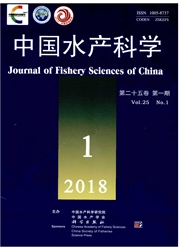

 中文摘要:
中文摘要:
比较分析了2015年冬季1月和春末5月黄海不同粒级浮游生物的脂肪酸组成,旨在对不同粒级网采浮游生物营养价值进行评价,为海洋鱼类营养补充研究提供基础资料。结果显示,冬、春两季,ω3多不饱合脂肪酸佃3PUFA)、二十碳五稀酸(EPA)、二十二碳六稀酸(DHA)、20:1+22:1的相对含量以较大粒级浮游生物(500~2000μml较高;而16:0、18:0不饱和脂肪酸的相对含量以〈500μm粒级浮游生物较高。冬季各粒级浮游生物的总饱和脂肪酸(SFA)相对含量均高于春季相应值,但MUFA、PUFA、16:1ω7、EPA、DHA、20:1+22:1的相对含量却低于春季。多元对应分析显示,环境因子中海水温度与100~1000μm粒级浮游生物的不饱和脂肪酸MUFA和PUFA含量呈显著的正相关关系(P〈0.05)。对比冬、春季浮游生物脂肪酸组成与黄海主要经济鱼类的脂肪酸营养组成,初步认为,在冬季,可为鱼类生长提供足够营养的浮游生物的粒级范围相对较窄,主要是〉500μm粒级的较大型的浮游生物,而在春季,该类浮游生物的粒级范围较广,100~2000μm的浮游动物都可作为鱼类早期生长的有效饵料来源。由此初步推论,浮游生物食性仔稚鱼食物来源的粒级范围在春季比冬季更为广泛。
 英文摘要:
英文摘要:
To understand the nutritional quality of planktonic food for marine fish, the fatty acid composition of plankton collected from the Yellow Sea was investigated and compared between winter and spring. As soon as the plankton were collected at sea, they were size-fractionated into six groups: 100, 200, 300, 500, 1000, and 2000 gm, and then immediately stored in liquid nitrogen. The fatty acid contents of the plankton were determined using capillary column gas chromatography in the laboratory. Compared with the spring-collected plankton, the winter-collected plankton in all size groups had higher total saturated fatty acid (SFA) contents, but lower contents of total monounsaturated fatty acids (MUFA), total polyunsaturated fatty acids (PUFA), and the fatty acids 16:1 ω7, eicosapentaenoic acid (EPA), docosahexaenoic acid (DHA), and 20:1+22:1. The different size groups of plankton collected in both winter and spring were compared. The contents of ω3PUFA, EPA, DHA, and 20:1+22:1 were higher in large plankton (〉 500 μm) than in small plankton (〈 500 μm). However, the contents of the fatty acids 16:0 and 18:0 were higher in small plankton than in large ones. Among the nutritional quality indicators (DHA/EPA, 16:1/16:0, and ∑16/∑18 ratios), the ∑16/∑18 ratio was higher in winter-collected plankton than in spring-collected plankton, while the DHA/EPA and 16:1/16:0 ratios were higher in spring-collected plankton than in winter-collected plankton. The DHA/EPA ratios reached to 2 in the 500μm and 1000 μm groups in winter, but were greater than or close to 2 in all size groups in spring. Multiple analyses showed that the seawater temperature had the strongest effect on the fatty acid composition of plankton in the Yellow Sea, especially the MUFA and PUFA contents in plankton of the 100-1000 μm size groups. The results of this study show that winter-collected plankton of 〉 500 μm could meet the nutritional requirements of marine fish, especially l
 同期刊论文项目
同期刊论文项目
 同项目期刊论文
同项目期刊论文
 期刊信息
期刊信息
